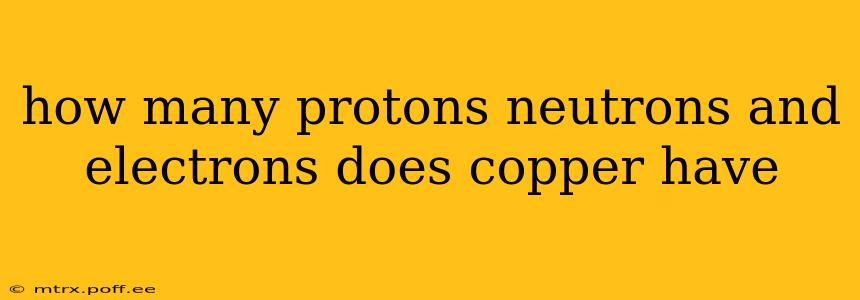How Many Protons, Neutrons, and Electrons Does Copper Have?
Copper, a reddish-brown metal known for its excellent conductivity, is a fascinating element with a specific atomic structure. Understanding its composition of protons, neutrons, and electrons is key to understanding its properties and behavior. Let's delve into the specifics.
The Basics: Atomic Number and Atomic Mass
To determine the number of protons, neutrons, and electrons in a copper atom, we need to look at its atomic number and its atomic mass. These values are usually found on the periodic table of elements.
-
Atomic Number: This number represents the number of protons in the nucleus of an atom. Copper's atomic number is 29. This means every copper atom has 29 protons.
-
Atomic Mass: This represents the total number of protons and neutrons in the nucleus. Copper has two main isotopes: Copper-63 (⁶³Cu) and Copper-65 (⁶⁵Cu). These isotopes differ in the number of neutrons.
- Copper-63: With an atomic mass of approximately 63, this isotope has 63 - 29 = 34 neutrons.
- Copper-65: With an atomic mass of approximately 65, this isotope has 65 - 29 = 36 neutrons.
-
Electrons: In a neutral atom (one that doesn't carry an electrical charge), the number of electrons is equal to the number of protons. Therefore, a neutral copper atom has 29 electrons.
In Summary:
| Isotope | Protons | Neutrons | Electrons |
|---|---|---|---|
| Copper-63 (⁶³Cu) | 29 | 34 | 29 |
| Copper-65 (⁶⁵Cu) | 29 | 36 | 29 |
Note: The numbers of neutrons can vary slightly depending on the specific isotope of copper being considered. The values above represent the most common isotopes.
What are isotopes?
Isotopes are atoms of the same element that have the same number of protons but a different number of neutrons. This means they have the same atomic number but different atomic masses. Copper-63 and Copper-65 are two naturally occurring isotopes of copper.
How do the number of protons, neutrons, and electrons affect copper's properties?
The number of protons defines the element (in this case, copper). The number of neutrons influences the atom's mass and stability (some isotopes are more stable than others). The number of electrons determines the atom's chemical reactivity and how it interacts with other atoms to form compounds. Copper's 29 electrons are responsible for its excellent electrical and thermal conductivity.
What are the applications of copper?
Copper's unique properties make it valuable in various applications, including electrical wiring, plumbing, and alloys. Its high conductivity makes it ideal for electrical applications, while its resistance to corrosion makes it suitable for plumbing.
This comprehensive explanation should provide a thorough understanding of the number of protons, neutrons, and electrons in a copper atom and how these numbers relate to its properties and applications.
